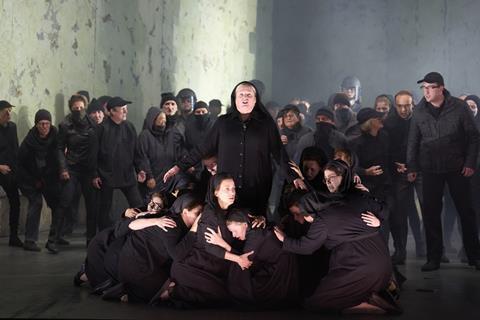The devastatingly powerful opera is a testament to human courage and, distinctly, female martyrdom. It also points to Christ’s ultimate sacrifice on the cross, says George Pitcher

I’d been warned to steel myself for the climax of Dialogues des Carmelites at Glyndebourne last weekend. So we had a stiff drink – well, Chablis, but plenty of it – during the 90-minute interval.
The denouement of “one of the most devastatingly powerful operas in [their] repertoire” features the historical martyrdom of 16 Carmelite nuns towards the end of the French Revolution’s Reign of Terror. The nuns sing the ‘Salve Regina’ as they are taken, one by one, to the guillotine, until Sister Constance is singing a solo. Actually, she’s joined at the end by one more sister, but we’ll come to that.
It is, naturally, as uplifting as it is macabre. The courage to give one’s life, rather than renounce one’s faith, is invariably so. And it’s also invariably in the face of a hateful worldly oppression, which is as inspiring as it is commensurate with the sacrifice of the cross.
The nature of female witness to a greater truth is a more striking defiance in the face of (literally) man-made brutality
But it also set me thinking specifically of the nature of women’s martyrdom. There is, historically, a difference between male and female martyrdom in time of war and conflict, and maybe we should acknowledge it.
Divine grace
First, to the opera. It deals with the finding and, indeed, the transfer of divine grace. Our dramatic heroine – there are, of course, 15 others – is Blanche de la Force, whose very name translates as something like ‘the power of innocence’. She joins the convent and becomes Sister Blanche of the Agony of Christ, which poignantly represents another kind of translation of her personhood.
Shortly after her initiation, the Mother Superior dies. To the disappointment of the nuns, she departs raving hysterically in fear. I have to say that I found this episode quite comical; maybe I was meant to.
Tending her grave, Constance speculates that perhaps we sometimes swap deaths with someone else, so that they might die a more noble, martyr’s death. Because the opera was written in the 1950s, this is made utterly accessible. She compares it with being given the wrong coat in a cloakroom, one whose sleeves are too short.
And she prophesies, correctly, that she and Blanche will die on the same day. Blanche, who has fled the monastery in fear, re-joins the end of the ‘Salve Regina’ queue for the guillotine. She has, if you like, found her Mother Superior’s coat.
A woman’s sacrifice
Is there something about the purity and innocence of these women’s sacrifice that sets it apart? I don’t know. But I do know that I found it especially moving. It’s as if the nature of female witness to a greater truth is a more striking defiance in the face of (literally) man-made brutality.
This is to take nothing from the countless male lives that have been willingly given in the fight against grotesque regimes such as Nazism, and other forms of fascism. To discriminate by gender here would be wildly egregious.
But it’s also true that, of the millions of lives lost deliberately in war, the overwhelming majority of male ones were in the course of fighting: dying of wounds on the battlefield, drowning at sea, atomised by shellfire, burned to death in aircraft. It’s the sheer absence of the women, historically, from the battlefield that puts their sacrifice into bas-relief.
Witness to the world
A word here about martyrdom. It’s in the nature of the Christian faith that the martyr has been appropriated for religious purposes. Again, this is to detract nothing from the saints, male or female, who died for their faith.
But martyrdom derives from the Greek word martur, which means ‘witness’. And that means anyone who witnesses, through their death at the hands of others, to a greater truth than their enemies can offer.
It’s here that the women of history have found their moment. I think of Edith Cavell, a nurse in the first world war in occupied Belgium, who was, intriguingly, given the leading name in the opera I’ve just seen, a member of an underground network called ‘La Dame Blanche’ that smuggled allied servicemen back to their own lines. She was captured and executed, declaring the night before her death: “Patriotism is not enough. I must have no hatred or bitterness towards anyone.”
The courage to give one’s life is as inspiring as it is commensurate with the sacrifice of the cross
Lest this smacks of nationalism, I think also of Sophie Scholl, a German member of the anti-Nazi group, White Rose, who was guillotined by her captors and died, aged 21, with the words: “It is such a splendid sunny day, and I have to go.”
Returning to the opera, I think of the political-religious crossover saint, Joan of Arc, refusing to compromise on nationhood or gender role, even to death. Which brings us back to 16 Carmelite nuns, refusing to accept the earthly authority of brutish revolutionaries.
As to Sister Constance’s observation, I can’t know who any of these women swapped the grace of their death’s with, but the origin of the Christian faith gives us the strongest clue.





































No comments yet